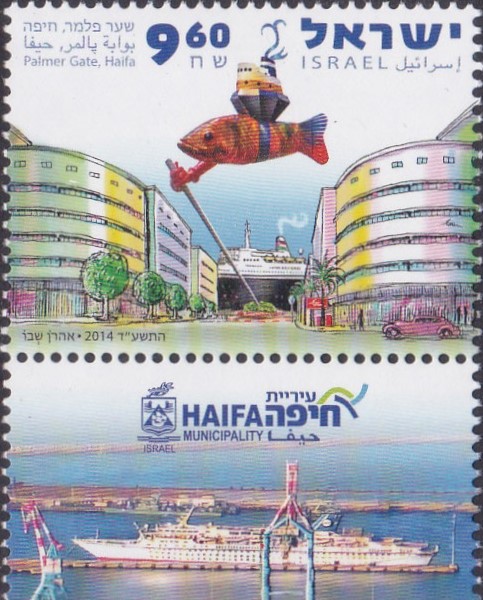
Palmer Gate, Haifa Port
A commemorative postage stamp on Port of Haifa : Gate number Five : Palmer Gate, Haifa :

 Issued by Israel
Issued by Israel
Issued on 23 Jun, 2014
Description of the Stamp and the First Day Cover : The Stamp features Palmer Gate Street and the port; part of a ship at the corner; and statue of a fish with a ship on its back, Zvika Cantor‘s City Fish, which was erected in 2010 in the Haifa–Boston Partnership square, located on the corner of Palmer Gate and Kdoshei Baghdad Streets in Haifa.
The First Day Cover features a photograph of the illegal immigration ship Eliyahu Golomb, docked in the Port of Haifa.
Photo by : Lipa Kugel, courtesy of “Bintivey Ha’apala”, The Clandestine Jewish Immigration Research Center in Memory of Admiral Mordechai (Moka) Limon.
Type : Stamp with Tab, Mint Condition and First Day Cover along with Stamp and a Special First Day Cancellation
Security mark : Microtext
Colour : Multi colour
Denomination : 9.60 Shekel
Plate : 946
Stamps per Sheet : 15
Tabs per Sheet : 5
Method of Printing : Offset
Printer : Joh. Enschede, The Netherlands
About :
- Holocaust survivors rose from the ashes of the crematoriums and immigrated illegally to Eretz Israel (Eretz Yisrael, The Land of Israel) during the British Mandate period. Under terrible conditions, on crowded decks of dilapidated immigrant ships, they made their way to the Promised Land, their hearts filled with hopes and dreams.
- The city of Haifa was the first thing that most Holocaust survivors saw as they approached the coastline. The bare concrete docks of the Port of Haifa were, to them, the Holy Land for which they yearned. They were part of an extremely dramatic and historic step taken by the Jewish people – the establishment of the State of Israel.
- Haifa Port was the entry point into Eretz Israel. Haifa was the Jewish people’s home port, both for the illegal immigrants (máaplim) who arrived prior to the establishments of the State and for the waves of immigrants who came after the State of Israel was established.
- Gate number five, which served for years as the mythological main entrance into the Port of Haifa, was later named Palmer Gate. The road leading out from the gate is also called Palmer Gate; named for Sir Frederick Palmer, a British engineer who planned and built the Port of Haifa from 1920 to its official opening in 1933.
- Palmer Gate Street is crossed by Port St. (Rehov HaNamal), which housed the administrative and commercial center of the port, and today is at the heart of the Port Campus – the academic center of Haifa’s downtown area.
- The Port Campus is a challenging project, which will turn an entire section of Haifa’s downtown into a complex of college campuses, dormitories and modern residential buildings, as well as supporting businesses that are typical of this type of complex.
- The Port Campus is very significant for the city of Haifa. The project reshapes the character and appearance of the city’s downtown, rejuvenates it and restores its past glory, and constitutes a critical phase in Haifa’s development.
- The above text by Yona Yahav, Mayor of Haifa.







